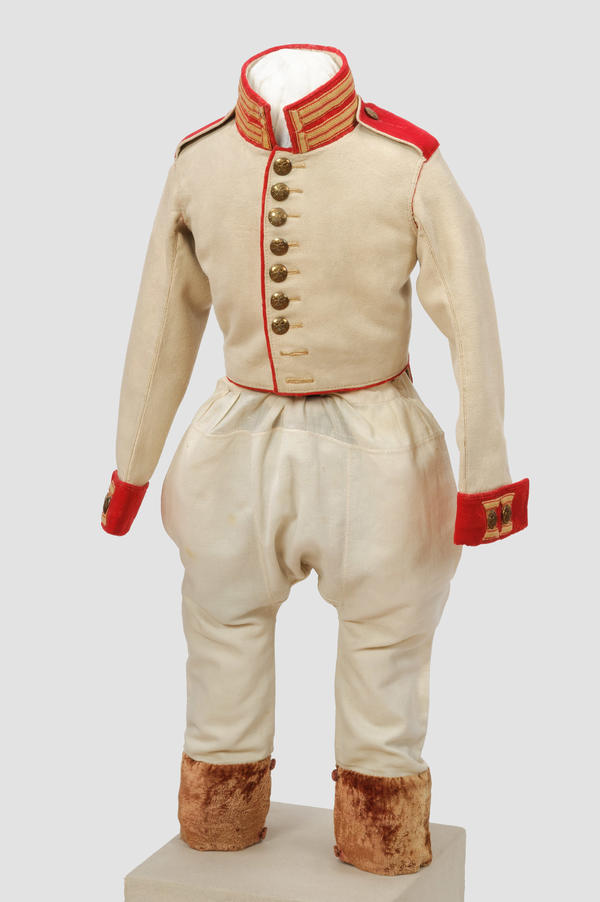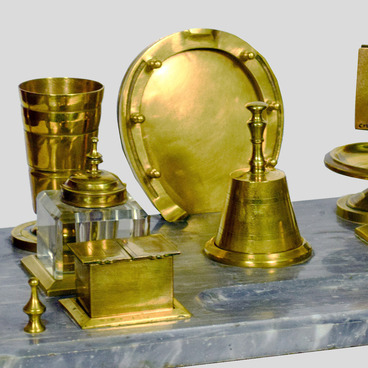This children’s military uniform belonged to Tsesarevich Alexander Nikolaievich, who would later become Tsar Alexander II. It is the uniform of the Russian Imperial Guard’s Horse Regiment Different materials were used to produce the uniform, including cloth, flannel, velvet and cotton chambray. The uniform consists of a white single-breasted tailcoat and bloomers. Red epaulets are attached to both shoulders. Yellow braid adorns the collar and red cuffs. The front of the tailcoat has nine buttons with coats of arms on them. Two of them now longer remain. The epaulets, cuffs and tails (which have a red cloth trim) are also adorned with the same buttons. There is a light-brown velvet section at the bottom of the bloomers.
Boys born into the royal family enlisted into military service until 1860. Tsesarevich Alexander was enlisted into the Horse Regiment of the Imperial guard from the moment he was born. Moreover, he was the Ataman (leader) of all the Cossack forces, as well as being attached to a range of elite regiments, including the Chevalier Guard Regiment, the Life Guard Horse Regiment, the Cuirassiers, the Preobrazhensky Regiment, Semyonovsky Regiment and the Izmaylovsky Regiment. In this way, he had the right to wear the Imperial Guards' Horse Regiment uniform.
The Imperial Guards' Horse Regiment uniform forms part of the museum’s collection dedicated to the Romanov dynasty. In 1920, the Guard’s uniform was transferred from the Saratov Pedagogical Museum as part of Semyon Yuryevich’s collection. He was the Tsesarevich’s tutor, who taught the future Tsar artillery, fortification and Polish. He accompanied Alexander Nikolaevich on his trips across Russia and Europe. He managed the Tsesarevich’s correspondence until 1850. Throughout this period, Yuryevich meticulously collected items, which would later form the bedrock of his unique collection. These items include a map of Ancient Rus’, painted by a twelve year old Alexander Nikolaevich. One item in Yuryevich’s collection corresponds to the final and tragic day of Tsar Alexander II’s life. It is a shard of glass from the Imperial Carriage, which was bombed during an attack on the Tsar, 1 March 1881.
The museum also preserves a photo of the grand opening of Alexander’s II monument in Saratov. The Tsar-Liberator’s monument as unveiled on 19 February 1911, on the 50th anniversary of the abolition of serfdom.
Boys born into the royal family enlisted into military service until 1860. Tsesarevich Alexander was enlisted into the Horse Regiment of the Imperial guard from the moment he was born. Moreover, he was the Ataman (leader) of all the Cossack forces, as well as being attached to a range of elite regiments, including the Chevalier Guard Regiment, the Life Guard Horse Regiment, the Cuirassiers, the Preobrazhensky Regiment, Semyonovsky Regiment and the Izmaylovsky Regiment. In this way, he had the right to wear the Imperial Guards' Horse Regiment uniform.
The Imperial Guards' Horse Regiment uniform forms part of the museum’s collection dedicated to the Romanov dynasty. In 1920, the Guard’s uniform was transferred from the Saratov Pedagogical Museum as part of Semyon Yuryevich’s collection. He was the Tsesarevich’s tutor, who taught the future Tsar artillery, fortification and Polish. He accompanied Alexander Nikolaevich on his trips across Russia and Europe. He managed the Tsesarevich’s correspondence until 1850. Throughout this period, Yuryevich meticulously collected items, which would later form the bedrock of his unique collection. These items include a map of Ancient Rus’, painted by a twelve year old Alexander Nikolaevich. One item in Yuryevich’s collection corresponds to the final and tragic day of Tsar Alexander II’s life. It is a shard of glass from the Imperial Carriage, which was bombed during an attack on the Tsar, 1 March 1881.
The museum also preserves a photo of the grand opening of Alexander’s II monument in Saratov. The Tsar-Liberator’s monument as unveiled on 19 February 1911, on the 50th anniversary of the abolition of serfdom.


